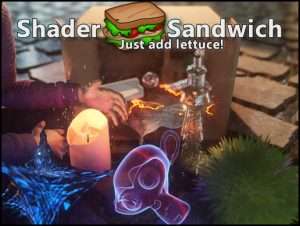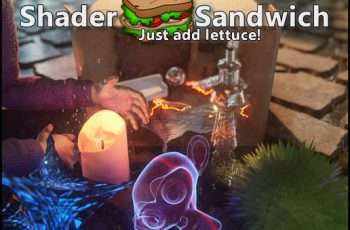
Detail this asset from Unity Store: Original Link
This is a paid asset, but now you can download Shader Sandwich Free.
Shader Sandwich v1718.2
Push your game’s graphical quality to the limit with Shader Sandwich!
Shader Sandwich is a layer based shader editor for Unity that allows you to create in an intuitive yet powerful environment, designed for artists rather than programmers.
It comes with example shaders and detailed documentation including a quick reference and in-depth beginner tutorials. Not that you’d need them however, as Shader Sandwich is designed to let you explore and fiddle as much as possible, in an iterative flow.
A few features (There’s too many to list!):
– Clean and streamlined interface similar to an image editor (Layers, blending modes etc).
– Choose from a multitude of layer types, such as textures, cubemaps, gradients, real-time noise (of many kinds), vertex colors and tons more.
– Add effects that – for example – let you blur, hue-shift, convert height-maps to normal-maps and many other cool things!
– Layer different lighting ingredients like Diffuse or Sub Surface Scattering with ease to create either normal shaders – like Unity’s PBR shader – or custom ones like cartoon, skin, or water shaders.
– Use and mix complex systems like Parallax Occlusion mapping and Tessellation easily, without having to worry about anything breaking.
– Use transparency with the option to z-write in a variety of ways, allowing transparent objects to appear correct in image effects and not overlap as often.
– Create inputs that let almost any setting be editable in the material inspector; link multiple settings to the same input, animate them and do a variety of other things to make your shader incredibly dynamic.
– Check out real-time 2D previews in the editor with no re-compile time, and another 3D previewer to get a more accurate look at your shader.
Shader Sandwich comes with:
– The editor itself (Source code included!)
– Some example textures (Ash, Lava, Cracked Ash, Bricks, Grass)
– Several example shaders (Diffuse, Rim light, Hologram, Greenscreen, Tessellated and Shell Based Fur, Lava Cracks, Mobile Wax, Realtime SSS, Fur, Water, Burn, Parallax Occlusion Mapped)
– Online and some offline documentation (That’ll be updated continuously)
– Free shaders that I’ll release periodically from the website.
Shader Sandwich has been built from the ground up with the artist in mind, for creating and shaping the look of a game. Be it for a more realistic pavement, or for a stylized cartoon world, Shader Sandwich can help make it happen.
Hey there! Welcome to the first of the three part set of beginner tutorials that’ll get you started with Shader Sandwich!
In this tutorial we’re going to be recreating a small portion of Unity’s standard shader – we’ll have a texture slot, a color that changes the color of the texture, and a slider for the metallness.
Now before we get started I just want to cover how Shader Sandwich fits into Unity, and how shaders and materials work together to render(show) an object.
When rendering an object in Unity, you need a Material, however, the material itself doesn’t do any rendering. It is simply a collection of settings such as textures, colors, numbers and cubemaps, that are then fed into the shader. The shader is what takes these settings – or inputs, as I’ll refer to them throughout the rest of the tutorials – and then goes through every pixel the object is on, and calculates lighting, places the texture in the right spot, applys the color, etc.
So with that out of the way, let’s create a shader!
This is the opening screen, where you can create new shaders and see a bunch of other stuff. On the left you can see your recently opened files, which in your case is probably blank, and on the right you can see some news which is updated every so often. Alright, enough of this, let’s begin!
Click New to create a new shader ?
Welcome to the layers screen. You’ll want to get familiar with this as the bulk of the shader will be made here. Shader Sandwich uses the concept of layers – such as colors or textures – that get wrapped around the object. This may not make sense immediately, but trust me, once we get started it’ll become pretty intuitive.
On the left are the selected layer’s settings, and then to the right of those are the layers themselves. Before we touch anything, we’re going to open up a preview window which will let us see the shader as we make it. Click on the Previews menu item, then click on Open Preview Window.
This is the preview window. Left clicking and dragging rotates the view, and right clicking and dragging zooms in and out.
Right at the bottom you can choose the ambient cubemap, and adjust lighting settings – these lights can be moved by holding down shift and using the same controls as the camera.
Just above these settings are those that allow you to choose the preview object, enable wireframe mode, and show the preview objects in the scene hierarchy.
Now, as a quick note, make sure to Never do what I say. Well, ok, you can, but be sure to mess around a bit. Use different colors, use different values, do whatever. Shader Sandwich is a very hands-on tool and it’s best learned by playing around :).
Ok, well lets get into making the shader. To start off, we’re gonna add a base color. To do this, we would normally have to add a layer; however Shader Sandwich starts off every new shader with a default color layer.
You can see its settings on the right – we’ll be going into what each of these do over the next few tutorials, but for now let’s focus on the top.
Here you can set the layer’s name, and it’s type – such as standard ones like Color or Texture, and more interesting ones like Cubist Noise or Depth.
Right underneath are the type settings, which allow you to change settings related to that layer type. For instance, I’m gonna go ahead and change the color setting.

